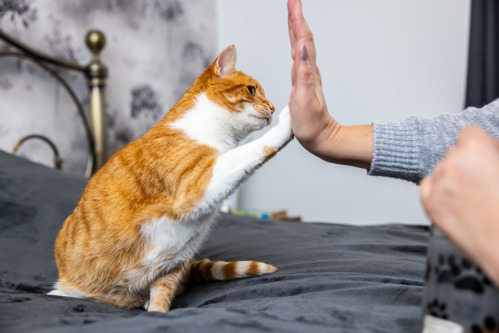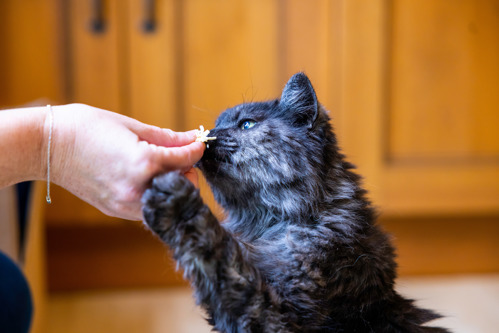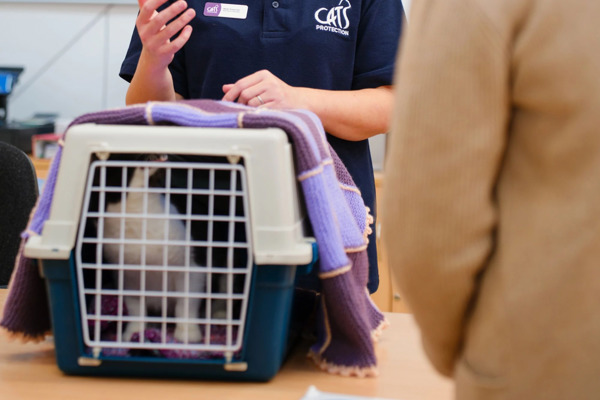Clicker training can be an effective way to teach your cat to perform tricks and behaviours
Training a cat is something rarely considered by cat owners. Unlike dogs, we usually think of cats as quite independent creatures who will only do things on their terms. While this is partially true, some cats can be trained to perform certain tricks.
When it comes to training a cat, clicker training can be an effective method. Clinical Animal Behaviourist Daniel Warren-Cummings gives his top tips for clicker training a cat.

What is cat clicker training?
Clicker training is a form of positive reinforcement training to teach cats to perform certain behaviours or tricks on cue. It involves using a clicker device as a marker to help cats identify the behaviour you want them to perform. The sound of the click, followed by giving them a treat, links the behaviour with a reward and encourages them to do it again.
Why use a clicker for cat training?
Using a clicker for cat training is often more effective than using a verbal cue. If you are using a verbal cue, it will need to be consistent and not something you would say to your cat at any other time. If you say the verbal cue without giving a reward, it will weaken your cat’s association with the cue. They will be less likely to grasp the training.
The clicker produces a more consistent sound that your cat is unlikely to hear in any other context. This helps them build a clear association with the click and their training. The consistency of a clicker is particularly useful if more than one person is training the cat.
How to clicker train your cat
- Pick the right moment. When training your cat, choose a time when they are feeling relaxed but awake. Make sure there are no other distractions.
- Link the click with the reward. You need to start by teaching your cat to associate the sound of the click with something positive. Click the clicker a short distance from your cat. Make sure they can hear it but that it isn’t so close or loud that it could startle them. You could click it inside your pocket or behind a cushion to muffle the sound a little. Once you’ve clicked the clicker, immediately give your cat a treat. Don’t make any other noises alongside the clicker to avoid confusing your cat.
- Repeat. Repeat step two several times until your cat starts to look for the treat as soon as they hear the clicker. This shows they associate the click with the reward.
- Choose a training goal. Decide what you want to train your cat to do. It’s best to start with something simple. Stick to one training goal at a time so your cat doesn’t get confused.
- Click and reward the behaviour. As soon as your cat does the behaviour you want them to do, immediately click the clicker and give them a treat. For example, if you are training them to sit, when they sit, immediately click the clicker and give the treat.
- Repeat. Repeat step five several times until your cat is performing the desired behaviour on cue every time. Keep using the clicker and giving the treat every time to reinforce this behaviour.
- Add other cues. Once your cat has mastered the training, introduce a visual or verbal cue alongside the clicker and treat. For example, if training them to sit, you could say ‘sit’ or raise your hand. Over time you can then start to phase out using the clicker and treat. Gradually decrease the frequency of rewards but keep the frequency consistent. For example, every other time then every fourth time. This is called a ‘schedule of reinforcement’.
Once your cat has mastered one trick or behaviour, you can move on to teaching them another. Keep encouraging them to perform the original trick every so often though, so they don’t forget it.
Why is clicker training a cat useful?
There are several benefits to clicker training your cat.
- It keeps their brain active. Training your cat provides great mental stimulation and can prevent them from getting bored. It encourages the release of happy hormones called endorphins in their brains to help improve their mood. If you have a particularly energetic cat, it can also help them burn off any excess energy.
- It strengthens their bond with you. Spending time training your cat is a great bonding activity. It can help you learn to trust each other and be more comfortable around each other.
- It can make your life easier. Training can be used to encourage your cat to do things that will benefit you and them. For example, you could train them to use the cat flap or be more comfortable with the cat carrier to make vet visits easier.

What tricks can cats learn through clicker training?
Clicker training can be used for lots of different behaviours and tricks.
You could use clicker training as part of our ‘how to’ training guides. Click and reward every time your cat performs the action correctly.
- How to train your cat to sit on command
- How to train your cat to lie down on command
- How to train your cat to roll over
- How to train your cat to accept handling
You could also use clicker training to teach your cat some other fun tricks such as:
-
do a fist bump or high five
-
jump through a hoop
-
fetch
-
ring a bell
Training can even be used to encourage some useful cat behaviours. For example:
- use the cat carrier. Look at our guide to cat carrier training and click and reward when they go into the carrier
- use the cat flap. Use clicker training along with our guide to train your cat to use a cat flap
- move to a specific place. You can train your cat to move to a specific spot using a target stick. Find out more below
Training with a target stick
A target stick is a device that you can train your cat to follow. Here’s how:
- Place the end of the target stick close to your cat and wait for them to touch it with their nose.
- When they touch the end of the stick with their nose, click the clicker and give them a treat.
- Repeat this process until they touch it consistently.
- Move the stick a short distance away from them. When they touch it with their nose, click the clicker and give a treat.
- Repeat this process, gradually moving the stick further away each time.
If you don’t have a target stick, you could use your hand instead. Eventually you will be able to use the target stick to encourage your cat to move into a particular spot. That could help to train them to:
- do a figure of eight around two cones
- walk through a tunnel
- hurdle objects
- free-jump from one raised object to another
- get into their carrier before going to the vet
What age should I start clicker training my cat?
Cats can be clicker trained at any age. Younger cats may be more likely to respond to the training more quickly. But older cats can get to grips with clicker training too.
Whether a cat responds to clicker training will depend more on their temperament than their age. Nervous, shy and anxious cats may struggle with clicker training.
7 tips for cat clicker training
- Make sure your cat is healthy. Before you start training, get your cat checked by the vet to make sure they are fit and healthy. Unwell cats may struggle with the training.
- Choose the right treats. When clicker training your cat, use a treat that you know they love and find irresistible. They’ll be more likely to respond to the training. It’s best to choose a treat that is quick to eat and doesn’t need much chewing. Otherwise, this could slow down the training.
- Don’t overfeed them treats. When using treats for training, avoid feeding them too many as this could make them overweight. Set aside a small portion of treats and when these run out, stop the training. Adjust how much other food you feed your cat that day to ensure they are getting the right number of calories.
- Give a treat every time. Even if you click at the wrong moment, still give your cat a treat. The clicker will only work if it signals a treat being given. Otherwise, your cat may get confused or lose interest.
- Get the timing right. When using the clicker, timing is important. Make sure you click exactly as the behaviour is happening. This will help the cat learn which behaviour they are being rewarded for. Before you start training your cat, try practicing with a friend or family member. Every time they perform a certain action, such as touching their nose, click as quickly as possible.
- It takes time and patience. Clicker training isn’t usually quick and easy. It can take anywhere from a few days to a few months to successfully clicker train your cat. Always be patient with your cat and never punish them for not getting it right. If you feel yourself getting frustrated, take a break and try again another time.
- It won’t work for every cat. Some cats may never get to grips with clicker training, but that’s ok. Some cats can be scared by the sound of the clicker, so a different method of training may be best for them. Try using a distinct verbal cue instead if the clicker scares them.



